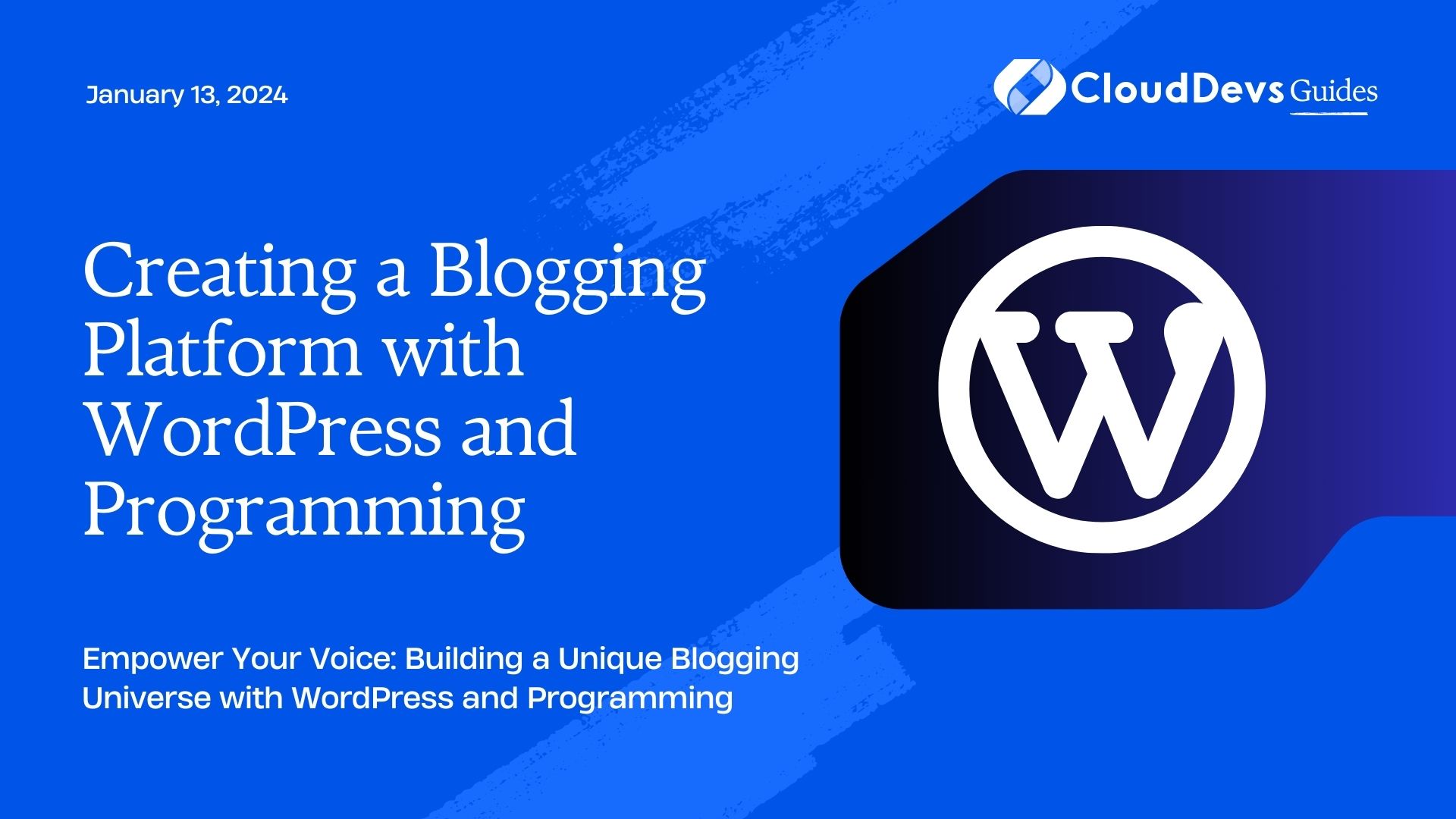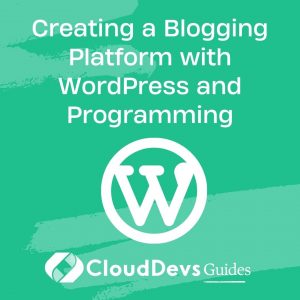Creating a Blogging Platform with WordPress and Programming
In today’s digital age, the art of blogging has evolved into a powerful tool for self-expression, marketing, and knowledge-sharing. With the rise of content creators, individuals, and businesses looking to establish an online presence, having a versatile and user-friendly blogging platform is crucial. WordPress, a widely used content management system (CMS), has proven itself as the go-to choice for building blogs and websites. However, to truly tailor your blogging platform to your needs, combining WordPress with programming skills can take your creation to the next level. In this guide, we’ll walk you through the process of creating a blogging platform with WordPress and programming, offering insights, code samples, and customization tips along the way.
Table of Contents
1. Introduction to blogging platforms
1.1. The synergy of WordPress and programming
WordPress is renowned for its user-friendly interface, allowing individuals with little technical knowledge to set up a website or blog effortlessly. However, the true power of WordPress lies in its extensibility through plugins and themes, which can be enhanced further with programming skills. By combining programming languages like HTML, CSS, PHP, and JavaScript, you can create a custom blogging platform that aligns perfectly with your vision.
1.2. Benefits of a custom blogging platform
While out-of-the-box solutions offer convenience, a custom blogging platform provides unparalleled flexibility and uniqueness. Programming empowers you to design bespoke templates, interactive elements, and specialized features that cater to your audience’s needs precisely. Moreover, having a personalized platform can set you apart in terms of branding, user experience, and functionality.
2. Setting Up WordPress
Before diving into programming, you need a solid WordPress foundation. Here’s how to get started:
2.1. Choosing a reliable hosting service
Selecting a reliable hosting service is crucial for optimal website performance. Opt for a hosting provider that offers sufficient resources, security features, and responsive support.
2.2. Installing WordPress on your server
Most hosting providers offer one-click installations for WordPress. Alternatively, you can manually install WordPress by downloading the package from the official website and following the installation instructions.
2.3. Navigating the WordPress dashboard
The WordPress dashboard is your command center. Familiarize yourself with its features, including post creation, media management, theme customization, and plugin integration.
3. Selecting and Customizing Themes
3.1. Exploring WordPress theme options
WordPress offers a plethora of free and premium themes catering to various niches and styles. Browse through the options and choose a theme that aligns with your blog’s purpose and aesthetics.
3.2. Customizing themes to match your vision
While pre-designed themes are a great starting point, customization is key to a unique platform. Modify colors, typography, layout, and other design elements to reflect your brand identity.
3.3. Implementing responsive design for mobile users
In today’s mobile-centric world, ensure your theme is responsive. Utilize media queries and flexible layouts to provide an optimal viewing experience on various devices.
4. Essential Plugins for Blogging
WordPress plugins extend the platform’s functionality. Here are some must-have plugins for your blogging platform:
4.1. Yoast SEO: Enhancing your blog’s visibility
Optimize your blog posts for search engines using Yoast SEO. This plugin provides real-time suggestions to improve your content’s readability and search engine ranking.
4.2. Akismet: Protecting your blog from spam
Spam can hinder user experience. Akismet automatically filters out spam comments, ensuring your comment section remains a space for meaningful interaction.
4.3. Social sharing plugins: Increasing content reach
Encourage social sharing with plugins like Social Warfare or AddToAny. These tools add easily accessible social sharing buttons to your blog posts, expanding your content’s reach.
5. Programming Your Blogging Platform
While themes and plugins offer a level of customization, programming allows for limitless possibilities. Here’s how to dive into coding:
5.1. Understanding the WordPress templating system
WordPress follows a template hierarchy that dictates how content is displayed. Familiarize yourself with this hierarchy to understand where and how to apply your customizations.
php // Example: Creating a custom template for single blog posts single.php -> single-customposttype.php -> single.php
5.2. Creating custom templates for different content types
Different content types, such as blog posts, pages, and custom post types, require unique templates. Develop templates that showcase content in the most engaging way.
php // Custom template for a specific category category-travel.php
5.3. Integrating HTML, CSS, and JavaScript for unique features
Use HTML, CSS, and JavaScript to implement interactive elements and unique features. For instance, you can add a dynamic content slider or a personalized user dashboard.
html <!-- HTML for a content slider --> <div class="content-slider"> <div class="slide">...</div> <div class="slide">...</div> <div class="slide">...</div> </div>
6. Crafting Engaging Content
Compelling content is the heart of any successful blog. Here’s how to create content that captivates your audience:
6.1. Writing compelling blog posts
Craft well-researched, informative, and engaging blog posts. Use clear headings, subheadings, and concise paragraphs to enhance readability.
6.2. Incorporating multimedia: images and videos
Visual content enhances the reader’s experience. Integrate high-quality images and relevant videos to complement your written content.
6.3. Using categories and tags effectively
Organize your content using categories and tags. This makes it easier for users to navigate your blog and discover related articles.
7. Implementing User Interaction
Facilitate user interaction to build a community around your blog:
7.1. Adding comment sections to blog posts
Engage with your readers by enabling comments on your blog posts. Encourage discussions and respond to comments to foster a sense of community.
7.2. Allowing user registrations and profiles
Grant users the ability to register and create profiles. This can lead to increased engagement as registered users can interact more deeply with your content.
7.3. Enabling user-generated content
Consider allowing users to submit their own guest posts or content. This not only diversifies your content but also encourages audience participation.
8. Advanced Customization with Coding
For those with more advanced programming skills, deeper customization is possible:
8.1. Editing theme files for precise design changes
Access your theme’s files to make targeted design changes. This level of customization ensures your platform looks and functions exactly as intended.
8.2. Developing custom plugins for specialized features
Create custom plugins to add unique functionality to your blog. Whether it’s an interactive quiz or a personalized recommendation system, custom plugins can set your blog apart.
8.3. Utilizing child themes to avoid theme update conflicts
When customizing themes, use child themes to preserve your changes during theme updates. This prevents your customizations from being overwritten.
9. Ensuring Security and Performance
A secure and performant blog is essential for maintaining user trust and engagement:
9.1. Regular updates and backups
Keep your WordPress core, themes, and plugins updated to patch security vulnerabilities. Regularly backup your website to safeguard against data loss.
9.2. Using security plugins to prevent vulnerabilities
Plugins like Wordfence or Sucuri can enhance your blog’s security by scanning for malware, implementing firewalls, and providing login protection.
9.3. Optimizing performance for faster loading times
A fast-loading blog improves user experience and SEO rankings. Optimize images, leverage caching plugins, and choose a reliable hosting plan for swift performance.
10. Launching and Growing Your Blog
With your blogging platform ready, it’s time to launch and grow your online presence:
10.1. Publishing your first blog post
Craft an attention-grabbing first blog post. Share it across your social media channels and encourage your audience to engage with your content.
10.2. Promoting your blog through social media and SEO
Utilize social media platforms to share your content and interact with your audience. Implement SEO best practices to increase your blog’s visibility on search engines.
10.3. Analyzing traffic and user engagement
Use tools like Google Analytics to track your blog’s performance. Analyze traffic, user behavior, and engagement metrics to refine your content strategy.
Conclusion
Creating a blogging platform with WordPress and programming is a journey that blends creativity and technical prowess. By harnessing the power of WordPress’s user-friendly interface and combining it with programming languages, you can craft a truly unique and impactful online presence. From setting up WordPress and customizing themes to coding custom features and ensuring security, this guide has equipped you with the knowledge to embark on this exciting endeavor. Remember, a successful blogging platform isn’t just about code; it’s about connecting with your audience through compelling content and fostering an engaging community. So, go ahead and bring your blogging aspirations to life with the perfect fusion of WordPress and programming. Your digital voice is waiting to be heard.
Table of Contents








